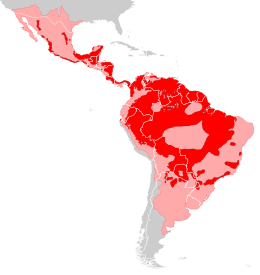
Back Jaguar Afrikaans የዱር ድመት Amharic Panthera onca AN Wīnlendisc panðer ANG يغور Arabic يغور ARZ Panthera onca AST Tukrunol (Panthera onca) AVK Jach'a titi Aymara Yaquar Azerbaijani
| Jaguar Temporal range:
Early Pleistocene – present (~850,000–0 YBP)[1] | |
|---|---|

| |
| Scientific classification | |
| Domain: | Eukaryota |
| Kingdom: | Animalia |
| Phylum: | Chordata |
| Class: | Mammalia |
| Order: | Carnivora |
| Suborder: | Feliformia |
| Family: | Felidae |
| Subfamily: | Pantherinae |
| Genus: | Panthera |
| Species: | P. onca
|
| Binomial name | |
| Panthera onca | |
| Subspecies | |
| |

| |
| Current range
Former range | |
| Synonyms[3] | |
| |
The jaguar (Panthera onca) is a large cat species and the only living member of the genus Panthera that is native to the Americas. With a body length of up to 1.85 m (6 ft 1 in) and a weight of up to 158 kg (348 lb), it is the biggest cat species in the Americas and the third largest in the world. Its distinctively marked coat features pale yellow to tan colored fur covered by spots that transition to rosettes on the sides, although a melanistic black coat appears in some individuals. The jaguar's powerful bite allows it to pierce the carapaces of turtles and tortoises, and to employ an unusual killing method: it bites directly through the skull of mammalian prey between the ears to deliver a fatal blow to the brain.
The modern jaguar's ancestors probably entered the Americas from Eurasia during the Early Pleistocene via the land bridge that once spanned the Bering Strait. Today, the jaguar's range extends from the Southwestern United States across Mexico and much of Central America, the Amazon rainforest and south to Paraguay and northern Argentina. It inhabits a variety of forested and open terrains, but its preferred habitat is tropical and subtropical moist broadleaf forest, wetlands and wooded regions. It is adept at swimming and is largely a solitary, opportunistic, stalk-and-ambush apex predator. As a keystone species, it plays an important role in stabilizing ecosystems and in regulating prey populations.
The jaguar is threatened by habitat loss, habitat fragmentation, poaching for trade with its body parts and killings in human–wildlife conflict situations, particularly with ranchers in Central and South America. It has been listed as Near Threatened on the IUCN Red List since 2002. The wild population is thought to have declined since the late 1990s. Priority areas for jaguar conservation comprise 51 Jaguar Conservation Units (JCUs), defined as large areas inhabited by at least 50 breeding jaguars. The JCUs are located in 36 geographic regions ranging from Mexico to Argentina.
The jaguar has featured prominently in the mythology of indigenous peoples of the Americas, including those of the Aztec and Maya civilizations.
- ^ Seymour, K. (1993). "Size change in North American Quaternary jaguars". In Martin, R. A.; Barnosky, A. D. (eds.). Morphological change in Quaternary mammals of North America. Cambridge University Press. pp. 343–372. doi:10.1017/CBO9780511565052.014. ISBN 978-0-521-40450-1.
- ^ a b Quigley, H.; Foster, R.; Petracca, L.; Payan, E.; Salom, R. & Harmsen, B. (2018) [errata version of 2017 assessment]. "Panthera onca". IUCN Red List of Threatened Species. 2017: e.T15953A123791436. doi:10.2305/IUCN.UK.2017-3.RLTS.T15953A50658693.en. Retrieved 15 January 2022.
- ^ Wozencraft, W. C. (2005). "Species Panthera onca". In Wilson, D. E.; Reeder, D. M. (eds.). Mammal Species of the World: A Taxonomic and Geographic Reference (3rd ed.). Johns Hopkins University Press. pp. 546–547. ISBN 978-0-8018-8221-0. OCLC 62265494.
